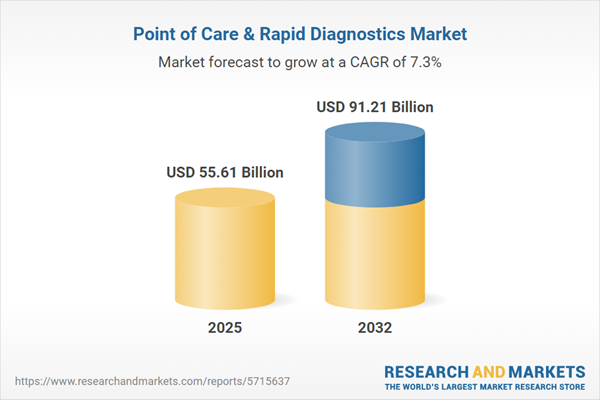Speak directly to the analyst to clarify any post sales queries you may have.
Point of care and rapid diagnostics are transforming healthcare by delivering immediate, actionable insights at the patient’s side. This acceleration of decision-making is shifting the market towards decentralized, technology-driven solutions for clinicians, payers, and care providers.
Market Snapshot: Point of Care & Rapid Diagnostics
The Point of Care & Rapid Diagnostics Market grew from USD 51.85 billion in 2024 to USD 55.61 billion in 2025. It is expected to continue growing at a CAGR of 7.31%, reaching USD 91.21 billion by 2032. This market’s trajectory is shaped by the rising prevalence of chronic diseases, demand for faster clinical workflows, and strong adoption across hospital, ambulatory, and at-home care settings. Senior decision-makers will find substantial opportunity amid evolving reimbursement frameworks and technological innovation propelling real-time patient engagement.
Scope & Segmentation
This report delivers comprehensive coverage of the point of care and rapid diagnostics landscape, analyzing crucial market drivers and detailed segmentation to support strategic planning. It examines all relevant product types, technologies, test types, end users, applications, and distribution channels while profiling leading companies across major geographies.
- Product Type: Consumables (Reagents, Test Kits), Instruments (Analyzers, Readers), Software & Services (Data Management Software, Support Services)
- Technology: Clinical Chemistry, Hematology, Immunoassay, Molecular Diagnostics
- Test Type: Cardiac Markers, Coagulation, Glucose Monitoring, Infectious Diseases, Pregnancy & Fertility
- End User: Ambulatory Care Centers, Clinics, Diagnostic Laboratories, Home Care Settings, Hospitals
- Application: Cardiac Care, Coagulation Testing, Diabetes Management, Infectious Disease Diagnostics, Oncology, Pregnancy Testing
- Distribution Channel: Direct Sales, Distributors, E-Commerce Platforms, Online Retail
- Region: Americas (North America: United States, Canada, Mexico; Latin America: Brazil, Argentina, Chile, Colombia, Peru), Europe, Middle East & Africa (Europe: United Kingdom, Germany, France, Russia, Italy, Spain, Netherlands, Sweden, Poland, Switzerland; Middle East: United Arab Emirates, Saudi Arabia, Qatar, Turkey, Israel; Africa: South Africa, Nigeria, Egypt, Kenya), Asia-Pacific (China, India, Japan, Australia, South Korea, Indonesia, Thailand, Malaysia, Singapore, Taiwan)
- Company Coverage: Abbott Laboratories, Roche Diagnostics International AG, Siemens Healthineers AG, Danaher Corporation, Thermo Fisher Scientific Inc., Becton, Dickinson and Company, bioMérieux SA, Quidel Corporation, Ortho Clinical Diagnostics GmbH, QIAGEN N.V.
Key Takeaways
- The increasing shift to decentralized care is accelerating adoption of portable and connected diagnostic platforms, streamlining lab-to-clinic workflows.
- Demand for sensitive, multiplex assay systems is enabling earlier and more precise intervention, directly supporting precision medicine strategies.
- Integration of diagnostics with health IT—including electronic health records and decision support systems—is now a core requirement for buyers in hospital and outpatient networks.
- Strategic collaborations between industry leaders, technology innovators, and public health agencies are enabling agile product development and regulatory navigation, especially in response to emerging health threats.
- Consumerization of diagnostics, including wearable devices and app-based interfaces, is breaking down traditional barriers to patient engagement and home-based monitoring.
- Implementation of value-based care models is driving the alignment of diagnostics with outcomes, incentivizing adoption of cost-effective, high-impact testing solutions.
Tariff Impact on Supply Chains and Cost Structures
Recent US tariff measures have intensified supply chain complexity for diagnostics manufacturers reliant on imported reagents and instrumentation. These challenges have prompted diversification strategies, expansion of domestic and tariff-free sourcing, and a move toward vertically integrated production to control costs. Procurement teams across healthcare settings are seeking new contract and rental models to balance higher input expenses.
Methodology & Data Sources
This research integrates primary insights from executive and management interviews across healthcare organizations with a thorough review of secondary sources such as peer-reviewed studies, regulatory documents, government publications, and company communications. Analytical modeling and expert validation ensure every trend and segment is substantiated and robust.
Why This Report Matters
- Informs investment and procurement strategies with multi-level segment and regional analysis tailored to your organization’s priorities.
- Clarifies how emerging technologies and regulatory trajectories will shape future competition and patient care models.
- Guides strategic supply chain adjustments, product portfolio management, and collaboration decisions to drive resiliency and growth.
Conclusion
The point of care and rapid diagnostics market is evolving rapidly, influenced by technology, regulatory responses, and changing patient needs. Decision-makers equipped with these insights will be positioned for long-term, sustainable advantage in the global diagnostic ecosystem.
Additional Product Information:
- Purchase of this report includes 1 year online access with quarterly updates.
- This report can be updated on request. Please contact our Customer Experience team using the Ask a Question widget on our website.
Table of Contents
3. Executive Summary
4. Market Overview
7. Cumulative Impact of Artificial Intelligence 2025
Companies Mentioned
The companies profiled in this Point of Care & Rapid Diagnostics market report include:- Abbott Laboratories
- Roche Diagnostics International AG
- Siemens Healthineers AG
- Danaher Corporation
- Thermo Fisher Scientific Inc.
- Becton, Dickinson and Company
- bioMérieux SA
- Quidel Corporation
- Ortho Clinical Diagnostics GmbH
- QIAGEN N.V.
Table Information
| Report Attribute | Details |
|---|---|
| No. of Pages | 183 |
| Published | November 2025 |
| Forecast Period | 2025 - 2032 |
| Estimated Market Value ( USD | $ 55.61 Billion |
| Forecasted Market Value ( USD | $ 91.21 Billion |
| Compound Annual Growth Rate | 7.3% |
| Regions Covered | Global |
| No. of Companies Mentioned | 11 |









